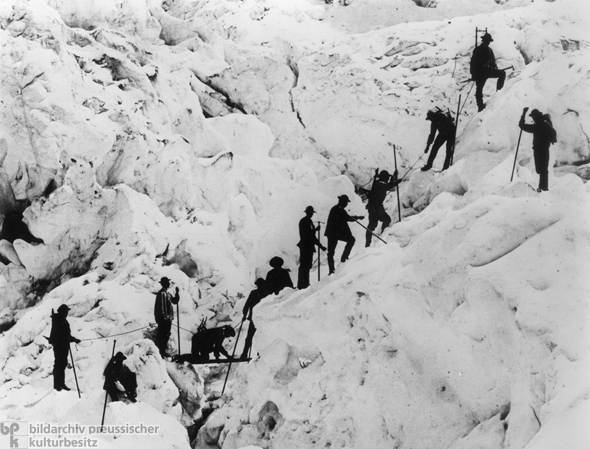|
Gletscherwanderung (um 1890)
Beeinflusst durch die Literatur der Romantik, in der die Natur menschliche Emotionen reflektierte und in ihrer Reinheit und Unberührtheit glorifiziert wurde, begann die deutsche Mittelklasse im 19. Jahrhundert, sich für das Wandern zu begeistern. Das Wandern wurde zu einer Möglichkeit der Naturerfahrung und der Aneignung einer besonderen und vertieften Kenntnis der Heimat durch die Einzelheiten ihrer Landschaft. Zahlreiche Wander- und Naturvereine wurden um die Jahrhundertwende gegründet, darunter auch der Wandervogel, ein Wanderverein für Jugendliche, der 1901 in einem Berliner Vorort entstand. Während einige Vereine sich auf Wanderungen durch deutsche Landschaften konzentrierten, lebten andere ihre Begeisterung für das Naturerlebnis auf extremerer Ebene aus, indem sie Berge und Gletscher in den Alpen erklommen. Sowohl in Deutschland als auch in Österreich gab es Ende des 19. Jahrhunderts Alpenvereine. Diese Vereine erleichterten das Wandern in den Alpen dadurch, dass sie Wanderpfade anlegten und Schutzhütten bauten, um den Bergsteigern einen Ruheplatz und Schutz vor den Elementen zu bieten. Das hier gezeigte Foto zeigt eine Gruppe von Bergsteigern, die in den 1890er Jahren einen Alpengletscher überqueren. Leitern werden benutzt, um den Kletterern beim Überqueren der Gletscherspalte zu helfen. Diese Art von Bergsteigen, die auch als Alpinismus bekannt ist, hat sich von dem bloßen Versuch, den Berggipfel zu erreichen, zu vielfältigen anderen Spezialisierungen wie Eisklettern und Telemark-Ski entwickelt.

|


